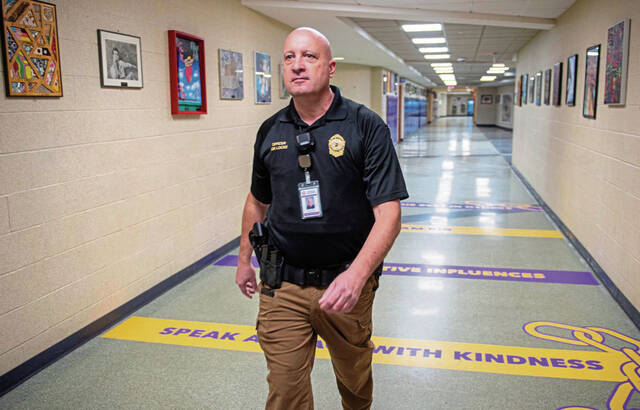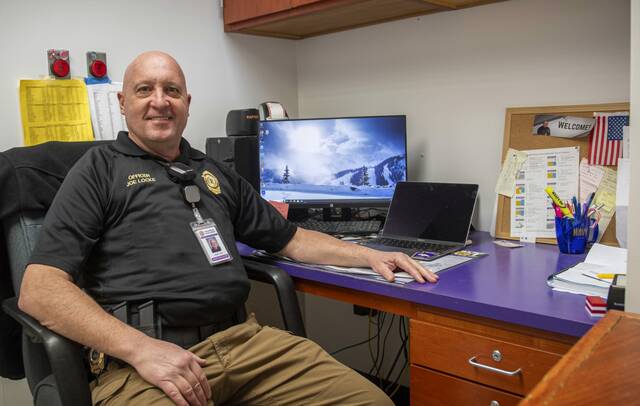Safer schools: Pa. program has intercepted over 120 weapons in schools before they could be used
Thirty-five weapons were intercepted before they could be used to commit acts of violence in Pennsylvania schools last school year, as officials credited the anonymous safety reporting system Safe2Say Something for preventing catastrophes.
Since the program’s inception six years ago, at least 123 weapons — including guns and knives — have been recovered based on information from tips, said Brett Hambright, spokesman for the state Attorney General’s Office, which runs the program.
“We know that this program has saved students’ lives,” he said. “We have received tips that allowed school personnel or law enforcement to intervene with students who were experiencing a mental health crisis or students who were contemplating suicide.”
Schools were required to implement Safe2Say by January 2019.
Last school year, Safe2Say received more than 32,800 credible tips statewide, ranging from the use of vape pens, online misconduct and bullying to mental health issues, school threats and potential shootings.
Safe2Say was one of several reports to Shaler Area officials when a Millvale teen brought a semiautomatic gun on a bus this school year.
In September, Burrell and Fox Chapel Area school districts received Safe2Say reports of possible threats against their schools, which prompted virtual instruction days.
Since its inception, the tip line has received more than 146,000 tips, excluding false reports and tests, Hambright said.
“If it saves one life, it’s worth it,” said Chad Roland, Kiski Area School District’s assistant to the superintendent for K-12 education and safety. “That, to me, is the value, and that value is priceless.”
Types of reports
School officials say the benefits of the reporting system outweigh unintended consequences, such as false or malicious reports, even if every report isn’t an emergency.
“A lot of what we’re getting is not lifesaving. It’s typically vape pens and things of that nature,” Roland said. “In those cases, we try to inform parents of the knowledge we received.”
But, he said, the system is critical in the rare cases related to possible suicide or self-harm. The tip line offers teenagers an outlet to find help and schools an opportunity to intervene.
Statewide, bullying and cyber bullying are by far the most common reports, with almost 6,400 tips last school year, Hambright said. Second, at about 2,700 tips, is smoking in school, followed by drug distribution or possession at more than 2,500, suicide or suicidal thoughts at about 2,400, inappropriate behavior at nearly 2,200, self-harm at about 2,000 and threats against another person at about 1,400.
The report divides tips by intermediate unit. At close to 2,500 tips last school year, the Pittsburgh-Mt. Oliver and Allegheny intermediate units had the most tips statewide. The Westmoreland Intermediate Unit had about 1,900 tips last school year.
In Plum, school officials and local police work collaboratively in responding to Safe2Say tips, said Assistant Superintendent Ashley Boyers.
Together, they determine what level of response is needed and whether police need to perform a welfare check. In the background, school staff plans how they can best support a student when they return.
“Anytime we can intervene and assist with students, it’s a positive,” Boyers said. “It does create a bit more awareness.”
Few false reports
The anonymity of the system, though, means there are those who misuse it.
About 4% of reports — more than 1,300 tips — made last school year were false, Hambright said.
Of those, about 750 were immediately identified as pranks by the call taker, and the other 600 were categorized as “deliberate abuse of system.” Those are tips that contain seemingly credible information but are proven untrue.
“False reports do temporarily divert resources,” Hambright said. “However, the overwhelming majority of Safe2Say Something tips involve valuable information that benefits students, schools and communities.”
Malicious false tips, while rare, can be disruptive and cause unnecessary concern among students and parents.
At Kiski Area, for example, the high school went into lockdown for a day in 2020 after a Safe2Say tip warned of an “act of violence” there. Although the threat was deemed not credible and students eventually went on with their school day, students were not able to change classes for part of the day and police with bomb-sniffing dogs had to sweep the building.
In 2022, a Coatesville Area High School student in Chester County was charged with making terroristic threats, threats to use weapons of mass destruction and criminal use of a communication facility after giving tips through Safe2Say that resulted in lockdowns, evacuations and the cancellation of school events.
According to the state Act 44 statute, a person who knowingly makes a false report can be charged with a third-degree misdemeanor. It often falls on law enforcement to obtain warrants and trace false reports. Hambright declined to describe the warrant and investigative process.
Crisis center analysts are trained to vet tips by conducting an anonymous dialog with tipsters to ensure enough information is provided for schools and local law enforcement to act upon. They categorize each tip as “life safety” or “non-life safety” to route the tip to the school and, when appropriate, police.
About 95% of Franklin Regional School District’s tips are credible, said Tim Skoog, the district’s director of safety and security. Twice since 2019 the school district had to request search warrants because of abuse of Safe2Say.
Allegheny Valley School District spokeswoman Jan Zastawniak believes that, for the most part, students have used the program responsibly.
“I don’t believe we’ve had a ‘false’ report,” she said. “The program is discussed at the beginning of the school year with students. The school police officers conduct this training and review. It is stressed that there are consequences to filing false reports.”
Value outweighs misuse
Franklin Regional has received about 55 tips this school year, Skoog said. Most deal with vaping or online misconduct.
“We get quite a few of self-harm Safe2Say reports — friends worried about friends harming themselves,” Skoog said. “That definitely pays off when you get a child help. They go to their friends for help, and they get it some way or another.”
The Burrell School District looks at Safe2Say as an additional “ear on the ground,” administrators say.
“For serious, legitimate concerns, that’s what it’s good for,” said Carla Roland, Burrell High School principal and director of safety and security. “We are fortunate here that, by and large, people look out for each other.”
About 6% of tips Burrell has received this school year have been bogus, Roland said. Its most common credible tips deal with smoking or vaping in school.
“We do investigate every one of them — people know that and they will use it because it has shown results when they need assistance,” Roland said. “I don’t think it’s been terribly abused, but there have been hiccups.”
Kellen Stepler is a TribLive reporter covering the Allegheny Valley and Burrell school districts and surrounding areas. He joined the Trib in April 2023. He can be reached at kstepler@triblive.com.
Remove the ads from your TribLIVE reading experience but still support the journalists who create the content with TribLIVE Ad-Free.


